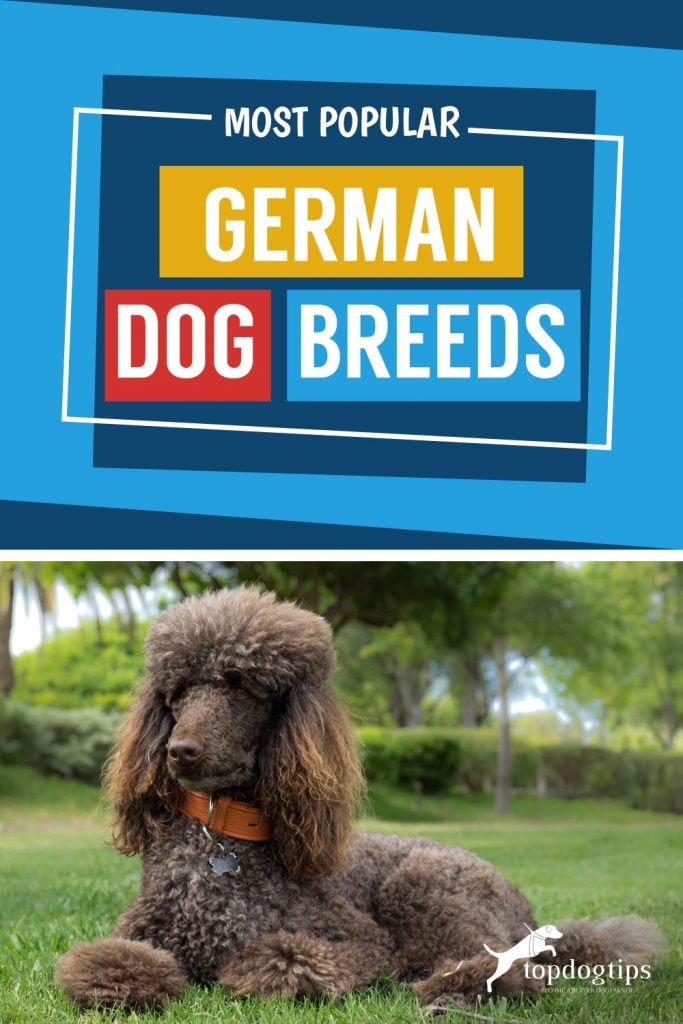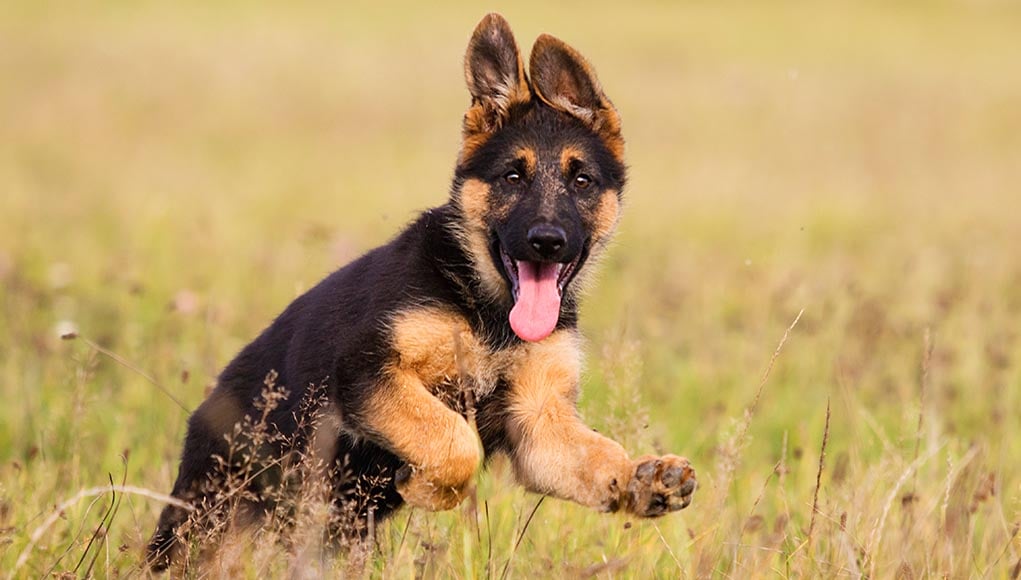German dog breeds are well known and loved around the world—no surprise since the country is the third largest producer of dog breeds, behind only France and the United Kingdom. Germany exports nearly 50 different breeds to the United States, and German dogs continue to climb in popularity. According to the American Kennel Club’s rankings for 2020 (based on its 2019 registrations), German dogs occupy a commanding eight spots in the top-twenty ranking of our most popular dogs. Let’s look at the top eleven German dog breeds in the United States.
Table of Contents
1. German Shepherd
This popular dog guards its lofty place at number 2 in the rankings. A German cavalry officer named Captain Max von Stephanitz started to cross German herding breeds in the late 1800s, trying to develop the best herding dog. He more than succeeded. Muscular and agile, the German Shepherd is the world’s third most intelligent dog. Only the poodle and border collie are smarter. This breed transitioned from herding to working for the military and the police.
The German Shepherd stands 22 to 26 inches high and weighs 50 to 90 pounds. The breed has a medium-length double coat, which comes in many colors and pattern combinations. Most of the year, when the dog isn’t shedding, brushing every few days is enough.
German Shepherds form close bonds with those they consider family. Aloof around strangers, they put their lives at risk to protect the people they love.
Highly trainable, this breed can learn many commands. They require early socialization and ongoing training to manage their protective instincts. German Shepherds also need a lot of exercise and enrichment activities. They excel at many canine jobs, along with dog sports like agility, herding, and tracking.
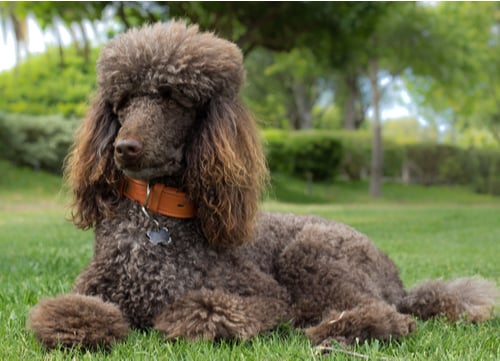
2. Poodle
Prancing in at number 6 comes the Poodle. Although many associate the poodle with France, this breed is actually German. The name “Poodle” originated from the German words “pudel” and “pudeln,” which means “puddle” and “to splash around.” Poodles were bred to hunt ducks more than 400 years ago, and they’re excellent swimmers. Poodles also served as companions to nobility and circus dogs. They’ve even been trained to find truffles.
The Standard Poodle stands more than 15 inches tall and weighs between 40 and 70 pounds. The Poodle comes in two other sizes: miniature and toy.
The Poodle’s curly coat protects it from inclement weather. The coat comes in solid colors or two-tone combinations, including shades of apricot, black, white, brown, gray, and more. Many people opt to keep their Poodle’s coat clipped short to avoid matting. The coat will need to be clipped every four to six weeks, either by the owner or a professional groomer. Since Poodles shed little, they make good pets for allergy sufferers.
Poodles are active, with a lot of energy. They require daily exercise and enjoy jogging or hiking, swimming, and playing fetch. They also excel in dog competitions like tracking and agility. Highly trainable and intelligent, Poodles learn basic commands in just minutes and are eager to please.
These affectionate dogs are good with children and form close bonds with their people.
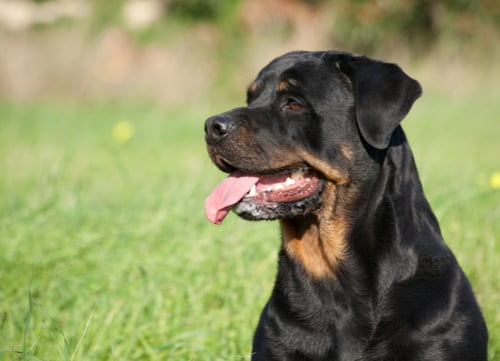
3. Rottweiler
Muscling in at number 8, this powerful dog has a bite force of 328 pounds, a bite stronger than a Pit Bull or German Shepherd. During the Roman occupation of Northern Europe, this breed was developed to herd livestock. The name came hundreds of years later, when these dogs herded cattle in the German town of Rottweil. This breed transitioned to working as police dogs, guard dogs, guide dogs, and search-and-rescue dogs.
Rottweilers stand 22 to 27 inches tall and weigh between 80 and 135 pounds. Their short black coat has rust, tan, or mahogany markings. The coat requires weekly brushing. Rottweilers shed heavily in spring and fall.
This breed has lots of energy, requiring daily exercise and an active owner. Rottweilers enjoy swimming, walking and jogging. They also excel in canine sports or work in herding or tracking.
Rottweilers are intelligent and highly trainable but can be stubborn. They need early socialization and training to manage their territorial instincts.
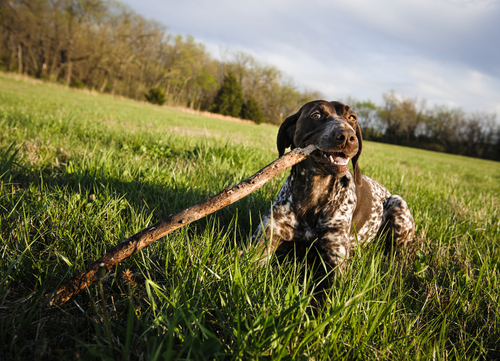
4. German Shorthaired Pointer
Claiming a spot at number 9, this dog was bred in the 1800s to hunt birds. They can retrieve from land or water, hunting several different kinds of game.
This pointer stands 21 to 25 inches high and weighs 45 to 70 pounds. The coat is reddish brown or sports a liver and white pattern. Maintenance consists of using a brush or grooming glove every few days.
Friendly, smart, and eager to please, German Shorthaired Pointers develop strong bonds with their people. With their boundless energy, they need a lot of exercise: a session of running, swimming, or other dog sport twice a day.
Early socialization and training is crucial for these intelligent dogs. Their high energy and strong prey drive has to be managed as they will engage in destructive behavior if left alone for too long.
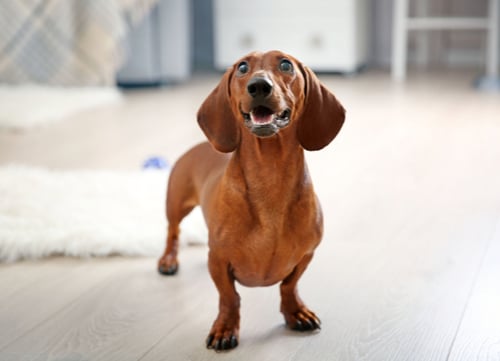
5. Dachshund
The world-famous “wiener dog” ranks 11th, with its floppy ears, long body, and short legs. Bred to hunt badgers around 600 years ago, the dog’s name translates from German as “Badger Dog.” Dachshunds pursued dangerous badgers right into their dens, and Dachshund packs also hunted wild boar. Consequently, this dog can be brave with a reckless streak.
The breed comes in two sizes: miniature and standard. The miniature version stands 5 to 6 inches tall and weighs less than 11 pounds. The standard version is 8 to 9 inches high and weighs between 16 and 32 pounds.
A Dachshund’s coat can be smooth, wire-haired, or long-haired and comes in shades of tan, black, chocolate, red, and more. This breed sheds occasionally and has little or no “doggy” odor.
This friendly, curious dog loves to be in your lap and may not get along with other dogs. Dachshunds make good watchdogs, with a bark that’s far bigger than they are.
Their elongated shape means a healthy back is critical. To keep their backs safe, Dachshunds shouldn’t run up and down steps or jump on and off furniture. Owners can help by feeding them appropriate portions; any extra weight they carry strains their backs. Enough exercise—around two moderate walks a day—should build strong back muscles.
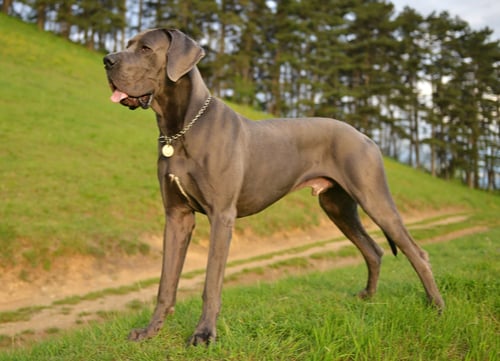
6. Great Dane
Many recognize this breed from cartoon characters Scooby-Doo and Marmaduke, both Great Danes. At ranking 17, this dog is a gentle giant. Originally bred to hunt boar, this breed has also performed as show dogs.
Great Danes measure up to 32 inches tall and weigh as much as 175 pounds. The short, smooth coat comes in black, fawn, blue, brindle (striped), and other colors and patterns.
This breed requires daily exercise, perhaps two or three brisk walks a day. They also enjoy jogs or hikes with their owners. Bred as hunters, they wander off when tracking scents so should be walked on leash and allowed to run only in an enclosed yard.
Great Danes are friendly and protective. They do well with children and other animals. Good watchdogs, they are alert and imposing. Because of their size, early training and socialization are needed.
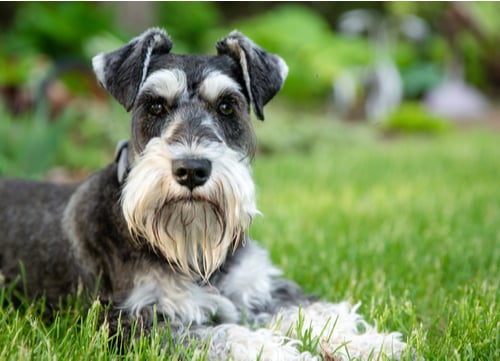
7. Miniature Schnauzer
Dashing in at number 18 is this small, lively dog. In the fifteenth century, this breed was developed to control rats and other vermin. Renowned German artists Rembrandt and Dürer painted the Schnauzer. The Schnauzer comes in three sizes: miniature, standard, and giant. All three types placed in the top 100 of the American Kennel Club rankings.
The Miniature Schnauzer stands 12 to 14 inches tall and weighs between 11 and 20 pounds. Their wiry coat comes in three colors: black and white, black and silver, and solid black. These dogs shed very little but do require regular grooming.
With their size and energy level, miniature schnauzers adapt well to apartment living and get along with children and other dogs. They make good watchdogs, although they can be barky.
Miniature Schnauzers need daily exercise and playtime with their people, with perhaps a safe fenced area so they can run and chase balls. This breed has a strong prey drive so should always be walked on leash.
Smart and trainable, early training and socialization will benefit them. The Schnauzer is one of the healthiest dog breeds, with few congenital issues.
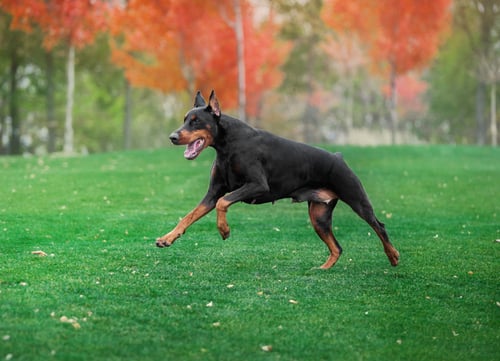
8. Doberman Pinscher
Following close behind the Miniature Schnauzer at ranking 19 is the Doberman Pinscher. A German tax collector named Karl Friedrich Louis Dobermann developed this breed in the late 1800s. He wanted a dog to protect him while he collected taxes. Doberman Pinschers have also served as guard dogs, police and military dogs, rescue dogs, and therapy dogs.
This large, muscular dog stands 24 to 28 inches tall and weighs 60 to 100 pounds. The short, smooth coat comes in black, red, blue, or fawn with rust markings. Grooming needs are minimal, only a quick daily brush or the use of a grooming mitt.
Doberman Pinschers should always be raised inside the house with their people. They may not do well with other dogs.
This breed needs lots of exercise and playtime with their people. They enjoy long daily walks or hiking and runs in a fenced yard. They also excel at dog sports, such as obedience, tracking, and agility. Doberman Pinschers also benefit from early socialization and obedience training.
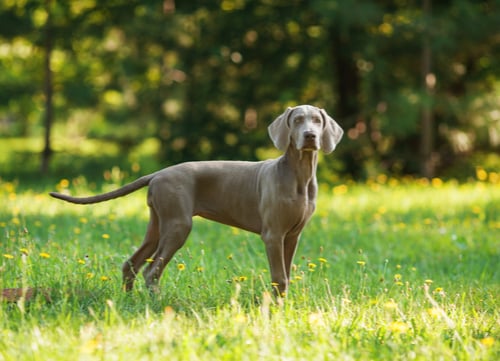
9. Weimaraner
Bounding in at spot 39 is a dog known as the “Gray Ghost,” because of its color and habit of sticking close to people. Named after the Weimer Republic (a state in Germany before World War I), these dogs were bred in the early 1800s for German royalty to serve as gun dogs for big game. Fearless, Weimaraners chased down deer, wild boar, and bears. Later they became bird dogs.
This elegant dog stands 23 to 27 inches tall and weighs between 55 and 90 pounds. Their short coat comes in blue, gray, or silver gray and only needs occasional brushing.
Weimaraners want to be part of the family and are good with children. They may not do as well with smaller pets. Playful and active, they need a lot of exercise to burn all their energy and a safe, enclosed yard with room to run. Their speed is up to 35 miles per hour, and running is important for their physical and mental health. Intelligent and eager to please, Weimaraners benefit from early socialization and training.
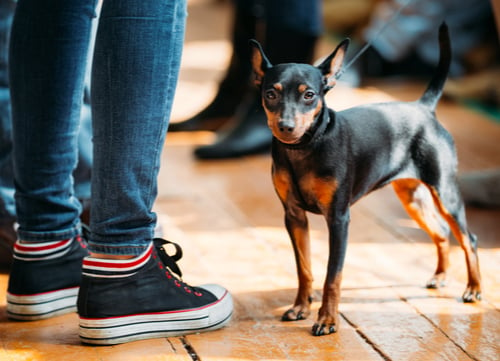
10. Miniature Pinscher
Ranked at 74 is this small dog with a big personality. The breed has a distinctive, high-stepping gait. Its origins are unclear, but most experts think the breed was a cross between a Dachshund and Italian Greyhound.
The breed stands approximately 10 to 12 inches high and weighs 8 to 10 pounds. The smooth short coat comes in red, chocolate and rust, or black and rust. Maintaining the coat requires only a weekly brush or use of a grooming glove.
The Miniature Pinscher needs daily exercise, perhaps walking a couple times a day or chasing balls in the yard. Independent, these dogs benefit from early socialization and training.
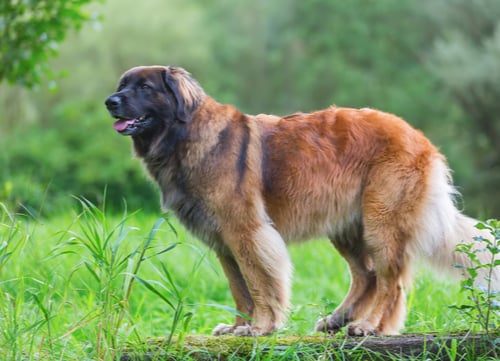
11. Leonberger
Our last German dog breed, coming in at 95 in the rankings, is a mix of Newfoundland, long-haired Saint Bernard, and Great Pyrenees. The dog’s name came from the city of Leonberg, Germany. In the nineteenth century, Heinrich Essig wanted to develop a dog that looked like the lion on Leonberg’s crest. These dogs with their lion-like manes were popular with royalty: The Prince of Wales, King of Italy, and Czar of Russia all had Leonbergers.
This large dog stands between 25 and 31 inches tall and weighs 90 to 170 pounds. The coat is medium-long and waterproof. It comes in red, reddish brown, sandy, and yellow. They require daily brushing because their hair tends to mat.
With their high energy level, Leonbergers need plenty of exercise at least once a day. Adult dogs can jog with their owners or run with a bike. Agility training is also another great source of exercise.
Friendly, outgoing dogs, they do well with children. Because of their size and strength, Leonbergers need early socialization and ongoing training.
Whatever kind of dog you’re looking for, German breeds offer a wide variety and the perfect companions for many people.
Read Next: Most Popular Irish Dog Breeds
